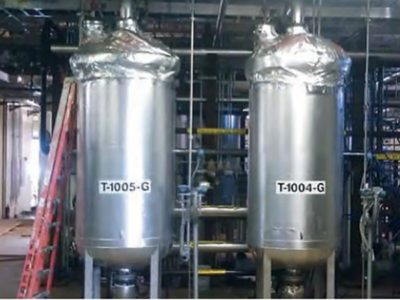Project highlights and product features
- In the field beta test of Dow’s AMBERSORB product on critical application
- Full-scale application to treat groundwater from impacted soil associated with a large thermal remediation project
- Treatment challenges included high concentrations and variability of 1,4-dioxane, other chlorinated constituents and thermal breakdown products including phenols and acetone
- System’s continuous operation avoided interruptions to the thermal processing, allowing early project completion
- Major components were redeployed after the project to address long-term 1,4-dioxane management on two full-scale sites
- Synthetic media provided a reliable and predictable outcome for high concentration and variable contaminant matrix
Simplified process design, reduced long-term operating costs
 ECT2’s full-scale synthetic media system was installed to treat 1,4-dioxane, other miscible contaminants and volatile organic compounds (VOCs) from groundwater extracted by an in situ thermal remediation system in Florida. The system was designed to treat 80 gpm of groundwater from a highly contaminated source area. The soil and groundwater were heated greater than 220 ºF during the 6-month remediation period. The water matrix was complex, as it contained elevated levels of 1,4-dioxane comingled with high levels of acetone, alcohols and phenols formed by multiple mechanisms, including decomposition of VOCs during soil/groundwater heating. Contaminant concentrations were highly variable from the source area to the edge of the plume. Concentrations also varied significantly in response to groundwater heating throughout the thermal remediation process.
ECT2’s full-scale synthetic media system was installed to treat 1,4-dioxane, other miscible contaminants and volatile organic compounds (VOCs) from groundwater extracted by an in situ thermal remediation system in Florida. The system was designed to treat 80 gpm of groundwater from a highly contaminated source area. The soil and groundwater were heated greater than 220 ºF during the 6-month remediation period. The water matrix was complex, as it contained elevated levels of 1,4-dioxane comingled with high levels of acetone, alcohols and phenols formed by multiple mechanisms, including decomposition of VOCs during soil/groundwater heating. Contaminant concentrations were highly variable from the source area to the edge of the plume. Concentrations also varied significantly in response to groundwater heating throughout the thermal remediation process.
The project objectives included short-term reduction of source concentrations, followed by long-term contaminant migration control. ECT2’s synthetic media treatment was selected because: (1) many of the miscible compounds were not amenable to air stripping; (2) the complexity and energy required for oxidation would have been prohibitive;(3) advanced oxidation processes proved ineffective for achieving low-level discharge due largely to the elevated concentrations of acetone and alcohols; and (4) granular activated carbon is susceptible to bed fires in the presence of high concentrations of some ketones. AMBERSORBTM 560 (AMBERSORB) was viewed as an emerging technology capable of improving operational reliability, complying with tight 1,4-dioxane permit limits, and simplifying process design while reducing long-term operating costs.
A dynamic, scalable and effective technology
ECT2 designed the system based on the results of extensive bench and pilot testing. Influent 1,4-dioxane concentrations ranged from 2,000 to 40,000 μg/l. Effluent concentrations were reduced by four- to-five orders of magnitude, were consistently below the 3.2 μg/l regulatory limit. The total “other miscibles” and VOCs were consistently removed from the 2,000 to 33,000 μg/l range down to non-detect levels.
Groundwater treatment during thermal remediation of a source area provided a highly concentrated, variable and challenging contaminant matrix. Synthetic media proved to be a dynamic, scalable and effective technology for these conditions, and holds significant promise as a reliable treatment technology for 1,4-dioxane and other miscible compounds and VOCs.
